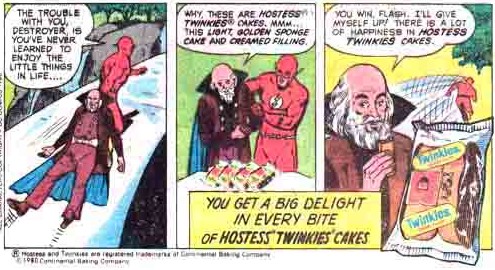 TwoMorrows’ book, The Flash Companion is now available! It debuted at Comic-Con last week, Amazon orders have been shipping, and it’s been showing up in stores.
TwoMorrows’ book, The Flash Companion is now available! It debuted at Comic-Con last week, Amazon orders have been shipping, and it’s been showing up in stores.
Here’s one more excerpt to round out the quartet of Scarlet Speedsters. As with the others, it’s posted here with permission of the book’s main author, Keith Dallas.

Mark Waid: Running on Impulse (excerpt)
By John Wells
WELLS: Why call him “Impulse,” rather than “Kid Flash”?
WAID: Because it was a perfect name. We didn’t want to call him “Kid Flash” because it sounded a little corny, and I still think it sounds a little corny. “Impulse” is the perfect confluence of a character’s name, his powers, and his personality, all in one word. And once we had the name — and I can’t swear it wasn’t Kurt Busiek’s suggestion — it completely summed up the character. Thought to deed in one motion without all those pesky synapses getting in the way.
WELLS: [laughs] It really did. Whose idea was that hair?
WAID: I think it was Humberto’s. Pure Humberto [Ramos]. Mike Wieringo had done the initial costume design, without the mask, but boy, Humberto went to town with the look, with the giant hair and the gigantic feet.
WELLS: Now kind of earlier on, you’d had the Tornado Twins revived in 1991’s Legion of Super-Heroes #18 and immediately had them executed by the Dominators.
WAID: [chuckles] “You” meaning “the Legion editors and writers after you left staff.” Don’t look at me, man.
WELLS: And later on, their DNA created a female speedster called Rush. And meantime, Don Allen was said to have been survived by his wife, Carmen Johnson and their two-year old son, Barry II. So what came first? You said you had the teen speedster idea for the Justice League story []earlier in the interview], was that before or after?
WAID: A little after, so that would have been the “Barry II” that we were talking about at the time, I suppose. But at that point, we were going to reboot the Legion with Zero Hour, so I knew that all bets were off in terms of Rush and those characters. It also freed up the name “Impulse,” which I believe was the codename of —
WELLS: Kent Shakespeare.
WAID: Kent Shakespeare, yeah.
WELLS: Iris brought Bart back to the 20th Century in the hope that Wally could cure her grandson, but she also wanted Wally to rein in Bart and train him in the use of his powers. Why was that not going to work?
WAID: It was so not going to work because Bart and Wally just hated each other. Wally saw in Impulse all of his own negative characteristics, so it put his teeth on edge.
WELLS: On the other hand, Max [Mercury] and Bart did work out pretty well, even though they didn’t think it was going to. How did you see that relationship?
WAID: We went into the Impulse series not sure who the mentor figure was going to be. And for a long time, I think we were talking about it being Jay, but Jay has his wife, Joan, and I don’t know what they could have brought to the series that wouldn’ t have been Ma and Pa Kent. Making Bart’s mentor Max, somebody who was so dry and so much the opposite of Bart, was too much comic potential to let go.
Continue reading →



